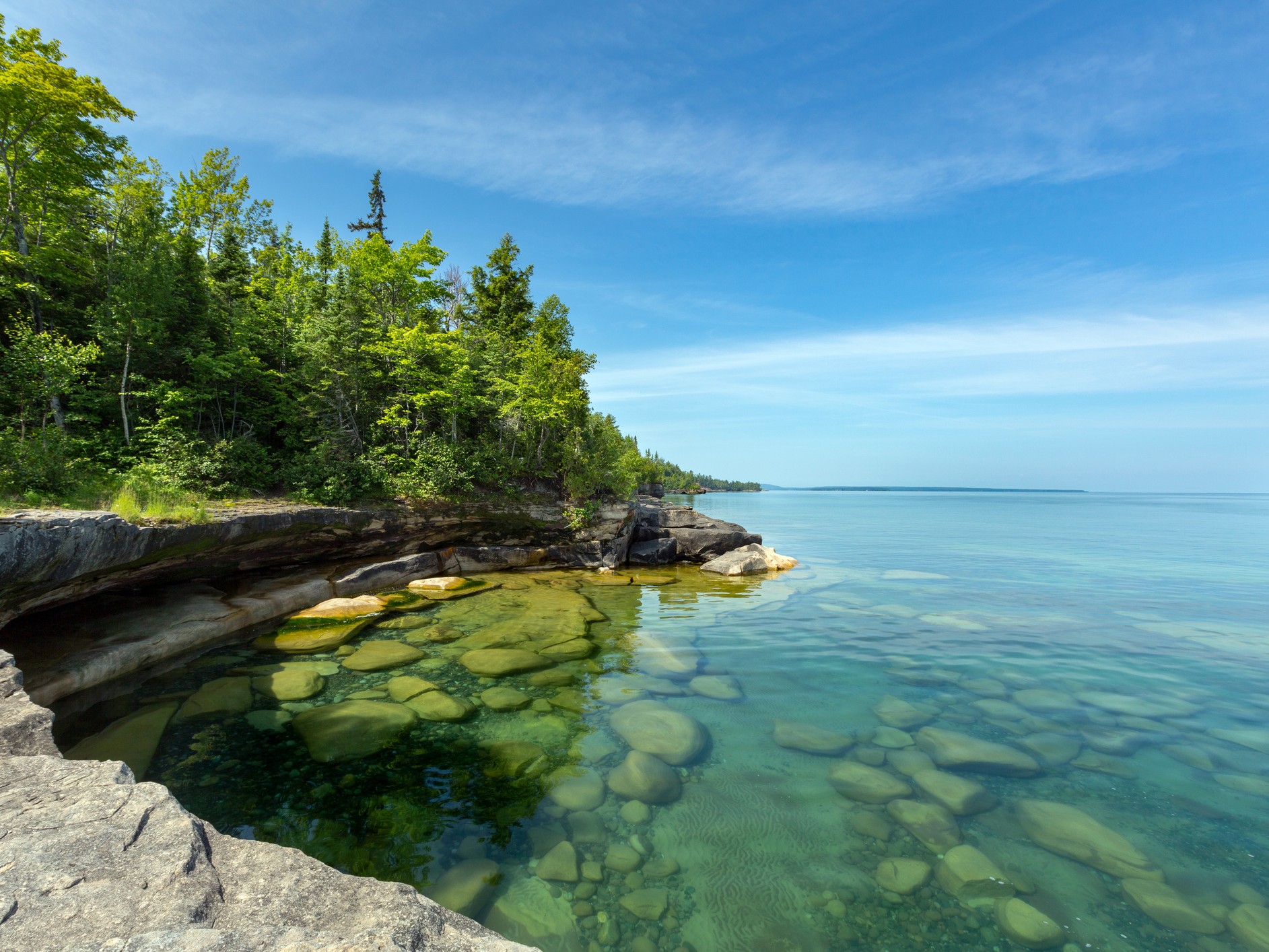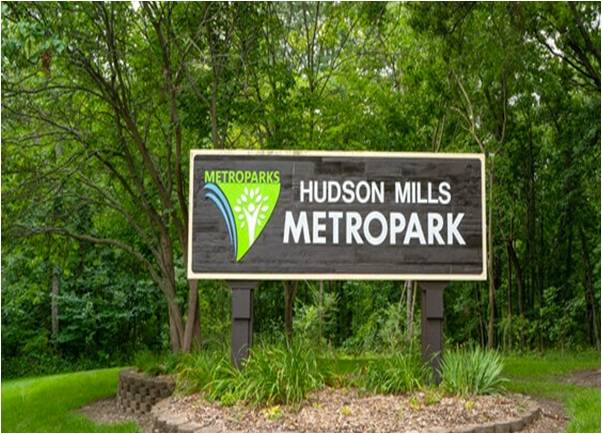Photo: The clear waters of Lake Superior reveal large rocks and stones underwater. Paradise Cove, with pristine waters, is located near Au Train, Michigan. Near Pictured Rocks National Lakeshore in the Upper Peninsula of Michigan. Photo by Craig Sterken
Lake Superior has been named the cleanest lake in the United States in a new 2025 report by Lake.com, which analyzed chemical data from the nation’s largest lakes. The study determined that Superior’s water registered virtually zero pollution, setting it apart from 45 other major lakes with recent water quality data.
“Lake Superior deserves its name all the more by virtue of its second-to-none crystal-clear water,” the study reported.
Speaking for the Watermark Project, American limnologist, Val Klump, Dean of the School of Freshwater Sciences at the University of Wisconsin-Milwaukee, was the first to reach Superior’s lowest depth of 1,333 feet. He knows the Great Lakes well. He says, “To call them lakes is really a misnomer; they’re really inland seas. They require oceanographic scale equipment and infrastructure to study them, but the major difference between the Great Lakes and Oceans is that we drink this water. That was kind of an ‘aha’ moment.”
Methodology
The rankings were based on data from the National Water Quality Monitoring Council, covering 100 of the largest U.S. lakes between January 1, 2020, and July 15, 2025. Of those, 46 lakes had at least three pollution indicators measured, allowing for accurate scoring.
Researchers assessed eight common water quality factors: dissolved oxygen, ammonia, lead, phosphorus, sulfate, total dissolved solids, turbidity, and pH. Each lake received a pollution score, with higher numbers indicating worse water quality.
“Compared to a similar study we carried out last year, comprising a different sample size, larger lakes seem to have three times less sulfates and nearly four times less TDS (Total Dissolved Solids),” said David Ciccarelli, CEO of Lake.com. “However, ammonia concentrations were five times higher in the lakes it was measured, while lead contamination was slightly lower.”
He added, “Overall, America’s largest lakes this year are technically a little murkier compared to our measurements from 276 lakes last year, but this would not be visible to the human eye. We are pleased to find that, generally speaking, large lakes remain very clean and safe to swim in, though monitoring any signage near swimming spots and adhering to the indicated advice may save you from catching a rare but nasty stomach bug.”
The Cleanest Lakes
- Lake Superior (Michigan–Minnesota–Wisconsin–Ontario)
- Lake Chelan (Washington)
- Lake Hartwell (Georgia–South Carolina)
- Lake of the Ozarks (Missouri)
- Lake Pend Oreille (Idaho)
- Lake Winnibigoshish (Minnesota)
- Kentucky Lake (Kentucky–Tennessee)
- Lake Norman (North Carolina)
- Lake Mead (Arizona–Nevada)
- Flathead Lake (Montana)
Lake Superior’s exceptional clarity is supported by its numbers: oxygen-rich at 10.45 mg/L, extremely low turbidity at 0.46 NTU, and a total dissolved solids reading of just 44.04 mg/L. Phosphorus levels were nearly undetectable.
The Dirtiest Lakes
- Lake Okeechobee (Florida)
- American Falls Reservoir (Idaho)
- Lake Texoma (Oklahoma–Texas)
- Eufaula Lake (Oklahoma)
- Lake Clark (Alaska)
- Lake George (Florida)
- Utah Lake (Utah)
- Oneida Lake (New York)
- Pyramid Lake (Nevada)
- Richland-Chambers Reservoir (Texas)
Lake Okeechobee ranked worst, with turbidity levels of 34.36 NTU and lead contamination of 0.67 µg/L. Phosphorus measured 0.18 mg/L, fueling algae growth and adding to the lake’s murky appearance.
Unique Facts About Lake Superior
Lake Superior is not only America’s cleanest lake but also the largest freshwater lake in the world by surface area, measuring 31,700 square miles (82,103 km²) — roughly the size of South Carolina or Austria. Its waters stretch an impressive 350 statute miles (560 km) in length and 160 statute miles (257 km) in width. The average depth reaches 483 feet (147 m), plunging to a maximum depth of 1,333 feet (406 m), making it the deepest of the Great Lakes.
Containing approximately 2,900 cubic miles (12,100 km³) of water, Lake Superior holds enough to cover all of North and South America under 12 inches (30 cm) of water. Its shoreline extends for 2,726 miles (4,387 km), including its many islands.
One factor contributing to its purity is its very small catchment-to-surface area ratio of 1.55, which means there is relatively little land draining into the lake compared to its size. This limits outside pollutants and gives Superior an unusual ecological advantage among large lakes.
The vast inland sea is also known for its power. Fierce storms can generate waves of more than 30 feet, and with an average water retention time of about 191 years, contaminants that do enter the system remain diluted over a long cycle. These features, combined with its cold, oxygen-rich waters, make Lake Superior one of the most unique and pristine freshwater ecosystems on Earth.
Klump underscored the importance of long-term stewardship, noting that protecting Lake Superior and the Great Lakes requires thinking far beyond the present moment:
“Someone once said: ‘the future has no constituency.’ In other words, my great-great-grandchildren can’t come back to me and say, ‘Val, why didn’t you do X, Y, and Z to ensure that these lakes are still clean, valuable, and in good shape.’ The other reason I care is because it’s really up to us. It’s not just me that needs to care; everybody needs to care. Those future generations are relying on us to make sure these lakes are going to be here 100 years from now, 500 years from now, and we need to take a long-range perspective I think.”





 8123 Main St Suite 200 Dexter, MI 48130
8123 Main St Suite 200 Dexter, MI 48130


